If you’re currently alive, you’ll recognize that breathing is a pretty big deal. Most people couldn’t tell you how often they do it (almost 30,000 times a day), but no one can live without it!
But most of us are doing it wrong.
 I joke with my clients that proper, mindful breathing is the most simple and effective, cheapest and safest therapeutic tool out there. Becoming aware of such a simple activity can have a tremendously positive impact on our physical health, mental health, and stress levels.
I joke with my clients that proper, mindful breathing is the most simple and effective, cheapest and safest therapeutic tool out there. Becoming aware of such a simple activity can have a tremendously positive impact on our physical health, mental health, and stress levels.
If you’re anything like most people in our modern society, you’re probably spending most of your breathing time inhaling air into your chest, without noticing or thinking about it. This tends to be the way most folks breathe most of the time (unless you’re specifically instructed to focus and lengthen your breath, say by a yoga teacher or a therapist). And obviously it works because you’re still alive, so what’s the big deal?
Breathing is intimately connected to our body’s stress response; you know, the well-known fight or flight (or freeze) response to something threatening or dangerous. When we are faced with a threat (and in our modern-day life, even something like a stressful email can count), our breathing tends to become very shallow and very quick. We may even lose it all together for a few seconds. This is a natural, instinctual response and serves us well when we need to get the hell outta there, but not so well when we’re just trying to live our lives.
The better option is something known as abdominal breathing, diaphragmatic breathing, or belly breathing, which is when we inhale fully into the bottom of our abdomen rather than into our chest or collarbone. The benefits are countless and varied. Among a long list, this type of breathing allows more oxygen to enter the bloodstream, encourages focus and concentration (a kind of relaxed, but alert feeling), lowers anxiety, inflammation, and blood pressure, improves digestion and posture, and quiets our body’s stress alarm, encouraging both mental and muscle relaxation. When we are able to slow down our breath and send it to the bottom of our belly, we are sending a message to our brain (through something science-y called the vagus nerve, which controls our parasympathetic nervous system, responsible for this relaxation response) that we are safe and okay.
So, take a few minutes and study your normal breathing. Are you able to breathe all the way into your diaphragm? An easy clue is to see which parts of your body are rising on the inhale. When I used to teach this to my young people clients, we’d lay on the floor and I’d put a small toy or stuffed animal on their belly to see if they could make it rise with their breath. Although we’re not all young people with toys and stuffed animals, a really easy way to practice this is by laying down and watching your belly rise, like it’s an expanding balloon that then deflates or falls on the exhale. Placing one hand on your abdomen can also help get the feel for it.
This is great to practice on a regular basis (even 5-10 conscious belly breaths a day!), and as you do, it will become easier and more automatic so you can use it in times of stress or when you feel all worked up. It’s also super effective before bedtime or if you wake up and can’t get back to sleep because your chatty mind won’t shut up.
I’ll be sharing other breathing techniques in another post, but for now, have fun relaxing!

